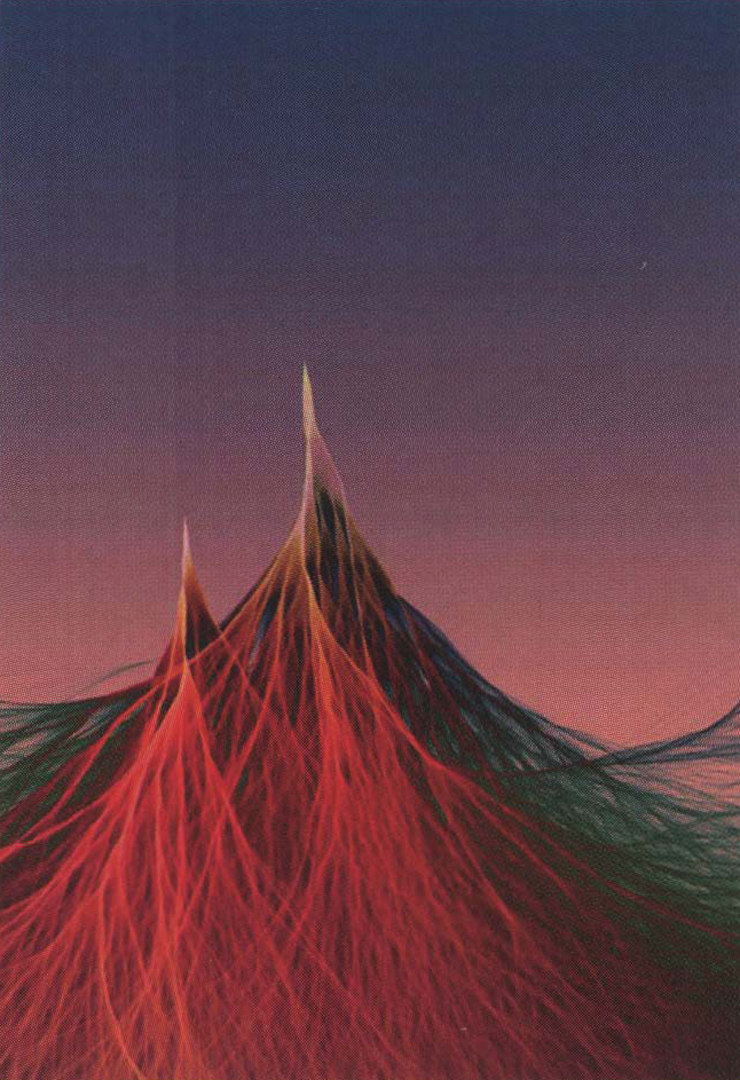Eric Heller: Transport IX
Artist(s):
Title:
- Transport IX
Exhibition:
Creation Year:
- 2004
Medium:
- LightJet digital image on Fuji Crystal archival photographic paper
Size:
- 26 inches x 22 inches
Category:
Artist Statement:
Transport IX renders electron flow paths in a two-dimensional electron gas. It is based on the actual electron flow patterns for electrons riding over bumpy landscapes. The electrons have more than enough energy to ride over any bump in the landscape, and the concentrations of electron flow are newly discovered indirect effects of that bumpy ride. The channeling or branching was unexpected and has serious implications for small electronic devices of the future. The Transport series was inspired by the electron-flow experiments of Mark Topinka, Brian Leroy, and Professor Robert Westervelt at Harvard. Scot Shaw of my group and I did the theoretical work. Transport IX follows the paths of electrons for a short time. It represents the effect of starting the electrons in a narrow beam at two different places on the random potential landscape on which they live. The distinct and overlapping patterns resulted from the particular hills and valleys encountered from a new location. It is seen that the branches emanating from different initial launch points cross and seem independent, confirming that they are not due to any fixed features in the potential landscape but rather are due to the history of encounters with hills and valleys “upstream.” There is a connection, a feedback from the science to the art and back again. In me, this has happened many times and has led to new scientific discoveries through the attempt to produce art. In the viewer and also in me, I strive for feedback of a different kind. I want the scene being rendered to evoke emotion and familiarity so the viewer can project back onto the science behind the image to sense the power and mystery in the world of quantum mechanics and the microscopic chaos that is just under the surface.
Technical Information:
The computer is a new artistic medium. It can draw fantastically detailed and imaginative things that are impossible for human hands to render. Most of the images in this work are produced pixel-bypixel using a computer algorithm, which I have written. I send the pixel data to a high end LightJet imager, where typically 150,000,000
pixels are rendered by a laser onto archival photographic paper. The paper is then developed in the traditional way in chemical baths. So far, the color brilliance and permanence of this method exceeds the best inkjet technology. As a theoretical chemical physicist, I have always taken a very visual and intuitive approach to my research, which involves application of quantum mechanics to various problems in the atomic world. I produce images as a regular part of my research, believing that the visual processing power we carry around with us is enormous, and that the right image can go a long way to prove a key point or leave a lasting impression on a colleague. Imagery is a formidable tool, to teach
ourselves, our colleagues, and the public. Images are increasingly being used in the mathematical and physical sciences. The computer has made them compelling, by drawing things of incredible information and detail (and sometimes beauty) in a short time.





